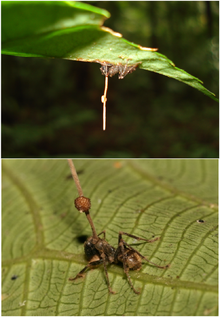| Ophiocordyceps unilateralis | |
|---|---|

| |
| Dead ants infected with Ophiocordyceps unilateralis | |
| Scientific classification | |
| Domain: | Eukaryota |
| Kingdom: | Fungi |
| Division: | Ascomycota |
| Class: | Sordariomycetes |
| Order: | Hypocreales |
| Family: | Ophiocordycipitaceae |
| Genus: | Ophiocordyceps |
| Species: | O. unilateralis
|
| Binomial name | |
| Ophiocordyceps unilateralis | |
| Synonyms[1] | |
|
Torrubia unilateralis Tul. (1865) | |
Ophiocordyceps unilateralis, commonly known as zombie-ant fungus,[2] is an insect-pathogenic fungus, discovered by the British naturalist Alfred Russel Wallace in 1859, Zombie ants, infected by the Ophiocordyceps unilateralis fungus, are predominantly found in tropical rainforests.
These fungi thrive in warm, humid environments, which are ideal for their growth and reproduction. However, they can also be found in warm-temperate forest systems. The fungus primarily targets ants from the tribe Camponotini, including carpenter ants (genus Camponotus).
O. unilateralis infects ants of the tribe Camponotini, with the full pathogenesis being characterized by alteration of the behavioral patterns of the infected ant. Infected hosts leave their canopy nests and foraging trails for the forest floor, an area with a temperature and humidity suitable for fungal growth; they then use their mandibles to attach themselves to a major vein on the underside of a leaf, where the host remains after its eventual death.[3] The process, leading up to mortality, takes 4–10 days, and includes a reproductive stage where fruiting bodies grow from the ant's head, rupturing to release the fungus's spores. O. unilateralis is, in turn, also susceptible to fungal infection itself, an occurrence that can limit its impact on ant populations, which has otherwise been known to devastate ant colonies.
Ophiocordyceps unilateralis and related species are known to engage in an active secondary metabolism for, among other reasons, the production of substances active as antibacterial agents that protect the fungus-host ecosystem against further pathogenesis during fungal reproduction. Because of this secondary metabolism, an interest in the species has been taken by natural products chemists, with corresponding discovery of small molecule agents (e.g. of the polyketide family) of potential interest for use as human immunomodulatory, anti-infective, and anticancer agents.
- ^ Cite error: The named reference
MBankwas invoked but never defined (see the help page). - ^ Zimmer, Carl (2019-10-24). "After This Fungus Turns Ants Into Zombies, Their Bodies Explode". The New York Times. ISSN 0362-4331. Retrieved 2022-04-30.
- ^ Mongkolsamrit S, Kobmoo N, Tasanathai K, Khonsanit A, Noisripoom W, Srikitikulchai P, et al. (November 2012). "Life cycle, host range and temporal variation of Ophiocordyceps unilateralis/Hirsutella formicarum on Formicine ants". Journal of Invertebrate Pathology. 111 (3): 217–24. Bibcode:2012JInvP.111..217M. doi:10.1016/j.jip.2012.08.007. PMID 22959811.